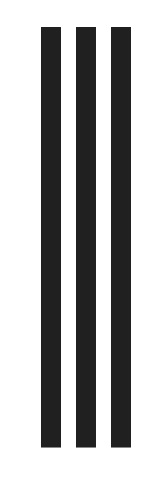At Adidas, lawsuits or out-of-court settlements in trademark matters are now on the daily agenda. Given the large number of brands, this is not surprising and the company does everything it can to counteract the dilution of its brands. A Black Lives Matter brand was also affected by this.
Adidas has been using its typical three stripes on clothing, bags and shoes for over 50 years. The stripes are already protected as a trademark. In the meantime, Adidas registers trademarks in various versions. Normally, the company is always well behind in enforcing its trademark rights. Lawsuits or out-of-court settlements are on the daily agenda.
Review: Cancellation of the Adidas stripes as a trademark
Interestingly, Adidas lost the following European figurative mark in 2019 due to a decision by the General Court of the European Union:

Source: EUIPO
The description of the figurative mark was: “The mark consists of three parallel and equally spaced stripes of uniform width applied to the product in any direction.”
Shoe branding europe successfully challenged the Adidas figurative mark with an invalidity action. An action for revocation can be used to declare invalid trade mark registrations that are contrary to EU law. In this case, the invalidity was based on the fact that the figurative mark was devoid of any distinctive character. Distinctiveness means that the mark must be capable of distinguishing the goods or services of one undertaking from those of other undertakings, so that the sign can be clearly associated with a particular undertaking. In particular, Adidas had failed to prove that the mark had acquired distinctive character throughout the EU as a result of use.
In order to do so, Adidas would have had to prove that the sign had acquired distinctive character throughout the EU as a result of recognition or use. In this context, the colouring is not unimportant. It makes a difference whether the stripes are used in white on a black background instead of black on a white background. After all, if a mark is extremely “simple”, even minor changes to that mark can be significant changes, so that the changed shape can no longer be considered to be largely equivalent to the registered mark. In that case, the trade mark can also be subsequently cancelled – as in this case.
Back to Black Lives Matter
Recently, Adidas and the Black Lives Matter Global Network Foundation got into hot water. The Black Lives Matter Foundation applied for a new trademark in the USA at the end of 2020. The logo contains three yellow stripes running parallel and should also be protected for goods such as clothing and bags. However, Adidas filed an opposition against this with the aim of preventing the registration. Adidas argued that the black lives matter foundation mark was so similar to Adidas’ previously used and previously registered three-stripe mark that registration of the black lives matter mark would be likely to cause confusion, deception or mistake as to affiliation, connection or association on the part of consumers. The issue is therefore the likelihood of confusion under trade mark law. A defect or other complaint found in the goods offered under the Black lives matter foundation trademark would inevitably reflect on Adidas’ reputation and could seriously damage it.
But it is precisely the matter of reputational damage that Adidas may have thought through again. Out of the blue, the company has decided to withdraw its initial objection. One can only speculate about the reasons. Many believe that Adidas wants to avoid bad press. The black lives matter foundation is a foundation that campaigns against racism, especially as a result of police violence. And Adidas has struggled recently because of allegations of racism within the company. A new “shitstorm” could spread to the detriment of Adidas in the event of such a trademark action against the Foundation. Given the choice between damaging its reputation by taking action against the planned brand and accepting a dilution of the Adidas brand through inconsistent rights management, Adidas has probably opted for the latter.
Author: Olivia Wykretowicz